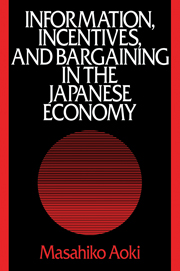 Information, Incentives and Bargaining in the Japanese Economy
Information, Incentives and Bargaining in the Japanese Economy Book contents
- Frontmatter
- Contents
- List of figures
- List of tables
- Preface
- 1 Introduction
- 2 The information structure of the J-firm
- 3 The ranking hierarchy of the J-firm as incentive scheme
- 4 Corporate finance, stockholding returns, and corporate governance structure
- 5 Bargaining game at the J-firm
- 6 The changing nature of industrial organization
- 7 Bureaupluralism
- 8 Culture and economic rationality
- Author index
- Subject index
2 - The information structure of the J-firm
Published online by Cambridge University Press: 14 January 2010
- Frontmatter
- Contents
- List of figures
- List of tables
- Preface
- 1 Introduction
- 2 The information structure of the J-firm
- 3 The ranking hierarchy of the J-firm as incentive scheme
- 4 Corporate finance, stockholding returns, and corporate governance structure
- 5 Bargaining game at the J-firm
- 6 The changing nature of industrial organization
- 7 Bureaupluralism
- 8 Culture and economic rationality
- Author index
- Subject index
Summary
In microeconomic textbooks, the firm is treated as a profit-maximizing agent whose technological opportunities are exogenously given in the form of the production function or the cost function. In other words, economists have treated phenomena that determine the costs of the firm as purely technological events occurring inside a “black box” and have relegated the task of inquiring about what occurs inside that box to industrial engineers. Thus, in microeconomics the firm can be identified with a single-minded entrepreneur who operates the black box to maximize profits in response to market signals.
This mechanical view of the firm was challenged some half century ago in a celebrated article by Ronald Coase entitled “The Nature of the Firm,” in which he asked why the firm emerged at all in the market mechanism. His answer was that a firm would arise and attempt to extend the range of its control as long as its costs were less than the costs of achieving the same result by market transactions. However, the significance of this article was not fully recognized until transaction cost economics, or the new institutional economics, revived interest in the question. As an alternative to market transactions, transaction cost economics identified the mode of transactions internalized in the firm with hierarchies.
The firm as a hierarchy may be visualized as follows: It is composed of many specialized operating units. The activities of these units are coordinated through layers of administrative offices.
- Type
- Chapter
- Information
- Information, Incentives and Bargaining in the Japanese EconomyA Microtheory of the Japanese Economy, pp. 7 - 48Publisher: Cambridge University PressPrint publication year: 1988


